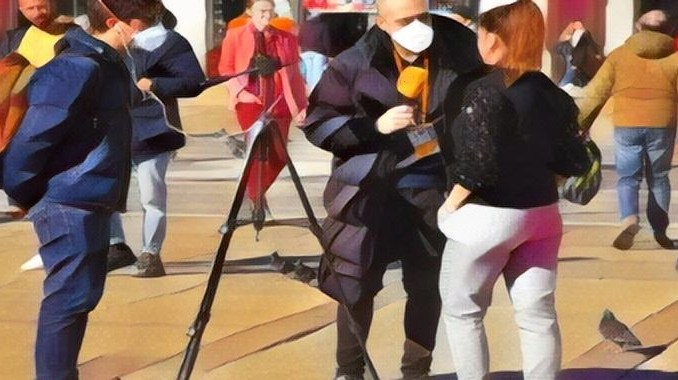
The media continues to cover the pandemic, while journalists die with coronavirus.
Nieman Reports describes that Guayaquil is one of the cities most affected by the coronavirus in Latin America. This has turned out to be lethal for those who report day by day on what is happening there. Around 13 journalists and people who work in the media have died until April 20.
The victims of this lethal disease, according to the Andean Foundation for Media Observation and Study are:
Luis Alberto Flores, de radio Estrella.
Olmedo Méndez, de radio Universal Guayaquil.
Roberto Román, de WQ Radio.
Víctor Hugo Peña, de Ecuavisa.
Ángel Sánchez, de la Prefectura de Guayaquil.
Manuel Varas, de Radio Caravana.
Paúl Tobar de Canal Uno.
Augusto Itúrburu, de diario El Telégrafo.
Carlos Loor, tramoyista de Canal Uno
Omar Paredes, chofer de diario Extra.
Omar Salvatierra, productor radial de i99.
Fernando Albán, excamarógrafo de RTS y TC Televisión.
Rosendo Escobar Cárdenas, propietario de RVT Satelital 91.5 FM.
The Journalists Without Chains Foundation reports that, in Guayaquil, the media are working with the minimum team of journalists because some are infected with the virus, others have asked not to work and others have been isolated due to their personal circumstances.
“They are working with 40% of the staff,” says Allen Panchana, an independent journalist and professor at the Catholic University of Guayaquil.
“We do not have powerful media economies that support journalists, I have friends who have paid for their COVID-19 tests and others who have come to sleep in hotels for fear of infecting their families,” says Panchana.
There are very few media outlets that send their journalists to the streets and work weekly divided shifts.
A fact that evidenced the mismanagement of the epidemiological circle was when the journalist Estefanía Ortiz had the opportunity to interview the sister of patient zero, who was outside her home without any protection measure and who died some time later.
After this interview, the journalist contacted the Ministry of Health to find out what to do, but no one answered. Therefore, the media paid for the test in a private laboratory and the journalist was quarantined until the possible contagion was ruled out.
Later, the media highlighted in their journalistic notes the mishandling of the dead in Guayaquil.
After the publication of notes related to the discovery of corpses victims of the coronavirus in the streets of that port city, the Council for the Regulation, Development and Promotion of Information and Communication sent two letters in which it exhorted them to “improve their journalistic practices”.
The media responded to the state entity saying:
“All our news (and headlines) are duly weighted by our journalists and editors, reflecting the pleas of thousands of Guayaquil residents who are facing a pandemic unprecedented in human history. We are not going to soften the reality, because to do so would be to miss the transparent exercise of our duty to communicate. ”
The State’s communication department has endeavored to spread its own content and to deny the fakenews during the health emergency.
Before, the authorities reported the data update twice a day, now they only do it in the morning. In addition, national chains with the summary of public management are recurring and overwhelming.
In many cases, public officials only appear touring hospitals and poor neighborhoods. They also show the acquisition of hospital supplies and the humanitarian aid that reaches the country.
Therefore, many media, which do not have the possibility of making coverage, reproduce these inputs that have a propaganda purpose.
The stories of the unburied dead that appeared in the city’s poor neighborhoods do not appear in these media pieces, despite the international media scandal.
But the collapse of the funeral system was so evident that it forced the authorities to publicly acknowledge the problem, showing images of the effectiveness of the Public Force that, day after day, deals with collecting and burying the remains of these people.
After the actions taken by the Public Force, the scenario would seem to have been controlled, but people continue to denounce that they do not find the bodies of their loved ones on social networks, and the authorities again deny this.
Until recently, it was very difficult to ask and cross-examine the authorities on this issue. For this reason, through a collective letter dated April 10, several journalists asked to change the form of virtual press conferences organized by the General Secretariat for Communication of the Presidency.
With the previous system, journalists sent their questions, but the authorities answered only some that were read by presenters. The responses were general or imprecise.
Some communicators claim that the authorities selected the questions and did not answer the uncomfortable ones.
Carolina Mela, an investigative journalist, warned of the lack of a protocol for handling the bodies, but never had a response from the health authority.
“I have criticized press conferences without the press from the beginning, that was a real disaster. Before the dead thing exploded, I tried to ask questions about the corpse management protocol, where they were going to be taken, whether or not there was going to be cremation. Only once did they pass my question and they formulated it wrong, in an extremely general way, “
Communicators say the same thing happens with requests for information. The Ministry of Health is the entity with the highest number of complaints because they almost never respond.
Journalist Mela requested information on biosecurity supplies and infected health personnel and received incomplete information after three days. In addition, she asked about the epidemiological fence of the mayor of Guayaquil, and insisted on the protocol for the corpses, through emails, but had no response either.
Lack of transparency is evident. The date of onset of disease symptoms is now reported instead of the confirmation date. For example, on February 29, when the first case of COVID-19 was confirmed in Ecuador, there were already at least 28 people with similar symptoms.
The province of Guayas, which includes Guayaquil, concentrates 70% of confirmed COVID-19 cases in Ecuador. Until April 17: There were 5,777 confirmed cases and 193 deaths, according to official statistics.
However, there are data that worry. For example, in the first fifteen days of April, more than 6,700 corpses were collected in Guayaquil, and there are 675 “probable deaths” where it was unknown, according to Jorge Wated, the official in charge of finding the unburied bodies. It is unknown how many of those thousands have died from COVID-19.
Authorities are now rehearsing press conferences through Zoom. But this has two problems: there are many journalists and very little time (these spaces last about one to two hours), so not everyone can ask.
Several officials respond through social networks, such as the Government Minister, María Paula Romo, but by this means the possibility of cross-examination is canceled and we return to the beginning.
Source: NiemanReports

Be the first to comment